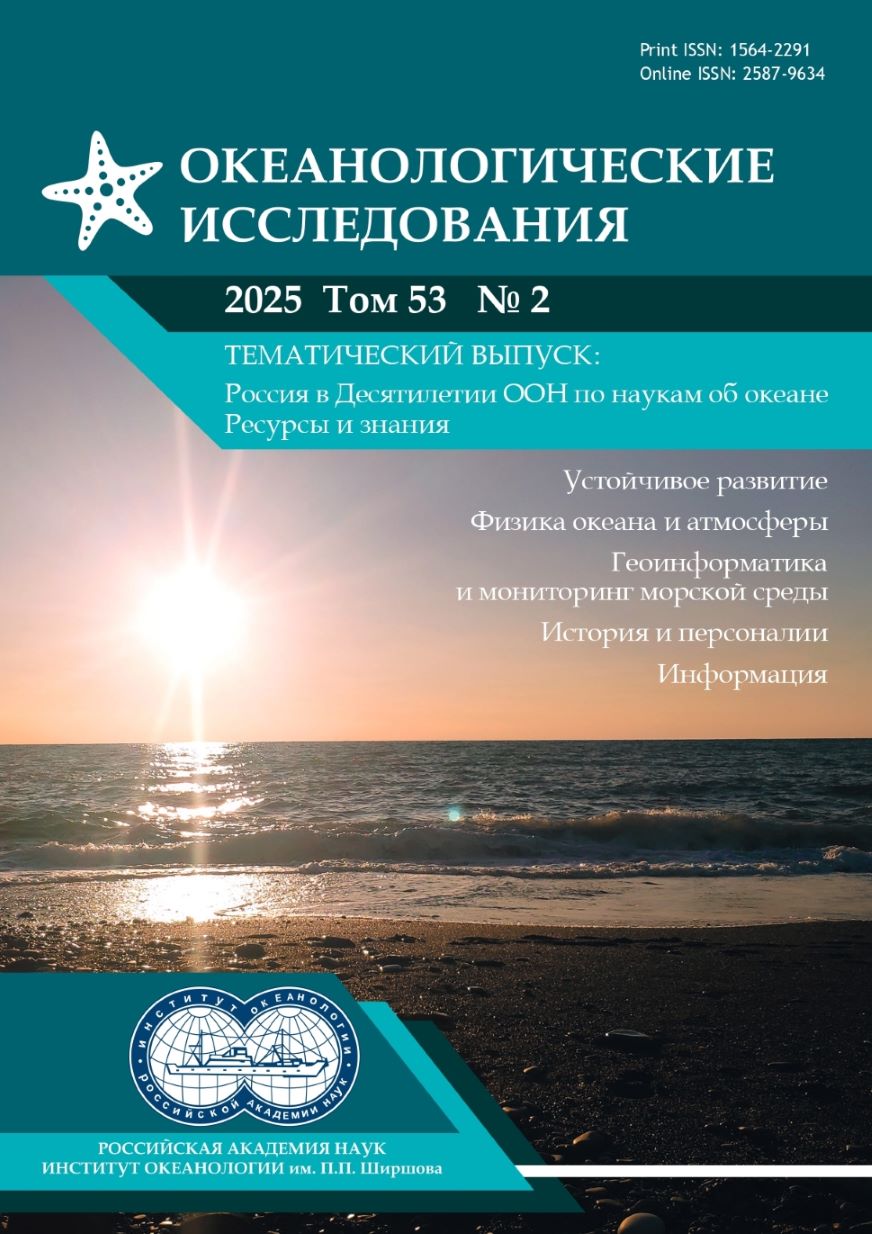SURFACE TEMPERATURE AND OCEAN LEVEL AT LOW LATITUDES AND THE NORTHERN SEA ROUTE
Abstract
The article presents estimates of the relationship between surface temperature and ocean level anomalies at low latitudes and air temperature and sea ice area in the Arctic seas along the Northern Sea Route. The initial data included archives of station meteorological data, atmospheric and oceanic reanalyses, long-term sea level data series, and Arctic sea ice area data. Multivariate correlation and regression analysis methods were used. The correlation of sea surface temperature and air temperature anomalies in the Arctic indicated areas in the ocean with the highest correlation coefficients between them. The areas in the tropical North Atlantic and in the Indo-Pacific positive sea surface temperature anomaly were identified. These areas also contain sources of sea level data – Key West in the tropical North Atlantic and Manila in the tropical western Pacific, the data series of which are most closely related to the anomalies of seasonal air temperature in the Arctic and with a lag of the latter up to 5 years. The sea surface temperature in the tropical North Atlantic and the Manila level turned out to be effective predictors for seasonal anomalies of air temperature and sea ice area in the waters of the seas of the Northern Sea Route. Forecast calculations of the ice area using an experimental regression model with a lead time of 4 years showed a correctness of 91 % and an efficiency of 30 % (on the original sample).
References
- Alekseev, G. V., A. E. Vyazilova, N. I. Glok, N. E. Ivanov, and N. E. Kharlanenkova, 2019: Vliyanie anomalij temperatury vody v nizkih shirotah okeana na kolebaniya klimata Arktiki i ih predskazuemost’ (The effect of water temperature anomalies at low latitudes of the ocean on Arctic climate variations and their predictability). Arktika. Ekologiya i ekonomika, 3 (35), 73–83, https://doi.org/10.25283/2223-4594-2019-3-73-83.
- Alekseev, G. V., N. I. Glok, A. E. Vyazilova, N. E. Kharlanenkova, and M. Y. Kulakov, 2021: Influence of SST in low latitudes on the Arctic warming and sea ice. Journal of Marine Science and Engineering, 9 (1145), https://doi.org/10.3390/jmse9101145.
- Alekseev, G. V., N. I. Glok, A. E. Vyazilova, and N. E. Kharlanenkova, 2020: Climate change in the Arctic : causes and mechanisms. IOP Conference Series: Earth and Environmental Science, 606, https://doi.org/10.1088/1755-1315/606/1/012002.
- Alekseev, G. V., S. I. Kuzmina, A. V. Urazgildeeva, and L. P. Bobylev, 2016: Vliyanie atmosfernyh perenosov tepla i vlagi na usilenie potepleniya v Arktike v zimnij period (Impact of Atmospheric Heat and Moisture Transport on Arctic Warming in Winter). Fundamentalnaya i prikladnaya klimatologiya, 1, 43–63, https://doi.org/10.21513/2410-8758-2016-1-43-63.
- Årthun, M. and T. Eldevik, 2016: On anomalous ocean heat transport toward the Arctic and associated climate predictability. Journal of Climate, 29 (2), 689–704, https://doi.org/10.1175/JCLI-D-15-0448.1.
- Deckker, P., 2016: The Indo-Pacific Warm Pool: critical to world oceanography and world climate. Geoscience Letters, 3 (20), https://doi.org/10.1186/s40562-016-0054-3.
- Dee, D. P., S. M. Uppala, A. J. Simmons, P. Berrisford, P. Poli, S. Kobayashi, U. Andrae, M. A. Balmaseda, G. Balsamo, P. Bauer, P. Bechtold, A. C. M. Beljaars, L. Berg, J. Bidlot, N. Bormann, C. Delsol, R. Dragani, M. Fuentes, A. J. Geer, … F. Vitart, 2011: The ERA-Interim reanalysis: Configuration and performance of the data assimilation system. Quarterly Journal of the Royal Meteorological Society, 137 (656), 553–597.
- Ding, Q., J. M. Wallace, D. S. Battisti, E. J. Steig, A. J. E. Gallant, H. J. Kim, and L. Geng, 2014: Tropical forcing of the recent rapid Arctic warming in northeastern Canada and Greenland. Nature, 509 (7499), 209–212, https://doi.org/10.1038/nature13260.
- Enfield, D. B., A. M. Mestas, D. A. Mayer, and L. Cid-Serrano, 1999: How ubiquitous is the dipole relationship in tropical Atlantic sea surface temperatures. Journal of Geophysical Research: Oceans, 104, 7841–7848.
- Goss, M., S. B. Feldstein, and S. Lee, 2016: Stationary wave interference and its relation to tropical convection and Arctic warming. Journal of Climate, 29 (4), 1369–1389, https://doi.org/10.1175/JCLI-D-15-0267.1.
- Gulev, S. K., M. Latif, N. Keenlyside, W. Park, and K. P. Koltermann, 2013: North Atlantic Ocean control on surface heat flux on multidecadal timescales. Nature, 499 (7459), 464–467, https://doi.org/10.1038/nature12268.
- Hoerling, M. P., J. W. Hurrell, and T. Xu, 2001: Tropical Origins for Recent North Atlantic Climate Change. Science, 292 (5514), 90–92.
- Hou, Y., N. C. Johnson, C.-H. Chang, W. Sun, K. Man, Y. Miao, and X. Li, 2023: Cold Springs Over Mid-Latitude North America Induced by Tropical Atlantic Warming. Geophysical Research Letters, 50 (16), e2023GL104180.
- Intergovernmental Panel on Climate Change (IPCC), 2023: Climate Change 2021 – The Physical Science Basis: Working Group I Contribution to the Sixth Assessment Report of the Intergovernmental Panel on Climate Change. Cambridge University Press, 2391 p.
- Kalnay, E., M. Kanamitsu, R. Kistler, W. Collins, D. Deaven, L. Gandin, M. Iredell, S. Saha, G. White, J. Woollen, Y. Zhu, M. Chelliah, W. Ebisuzaki, W. Higgins, J. Janowiak, K. C. Mo, C. Ropelewski, J. Wang, A. Leetmaa, R. Reynolds, R. Jenne, and D. Joseph, 1996: The NCEP/NCAR 40-year reanalysis project. Bulletin of the American Meteorological Society, 77 (3), 437–471, https://doi.org/10.1175/1520-0477(1996)077<0437:TNYRP>2.0.CO;2.
- Malinin, V. N. and M. A. Smirnov, 2022: Izmenchivost’ urovnya v tropicheskoj zone Tihogo okeana i El-Nino – Yuzhnoe kolebanie (Variability of the sea level in the tropical zone of the Pacific Ocean and El-Niño – Southern Oscillation). Gidrometeorologiya i ekologiya, 68, 463–477, https://doi.org/10.33933/2713-3001-2022-68-463-477.
- Meehl, G. A., C. T. Y. Chung, J. M. Arblaster, M. M. Holland, and C. M. Bitz, 2018: Tropical decadal variability and the rate of Arctic sea ice decrease. Geophysical Research Letters, 45 (20), 11,311–326,333.
- Mokhov, I. I. and D. A. Smirnov, 2006: Issledovanie vzaimnogo vliyaniya processov El-Nino – Yuzhnoe kolebanie i Severo-Atlanticheskogo i Arkticheskogo kolebanij (Study of the mutual influence of the El-Niño – Southern Oscillation and the North Atlantic and Arctic Oscillations). Izvestiya RAN. Fizika atmosfery i okeana, 42 (5), 650–667.
- Nesterov, E. S., 2000: Izmenchivost’ harakteristik atmosfery i okeana v Atlantiko-evropejskom regione v gody sobytij El-Nino i La-Ninya (Variability of atmospheric and ocean characteristics in the Atlantic-European region during El-Niño and La-Niña events). Meteorologiya i gidrologiya, 8, 74–83.
- Nesterov, E. S., 2013: Severoatlanticheskoe kolebanie: atmosfera i okean (North Atlantic Oscillation: atmosphere and ocean). Moscow, 144 p.
- Polonsky, A., 2019: The ocean’s role in climate change. Cambridge Scholars Publishing, 294 p.
- Prokhorova, U., G. Alekseev, and A. Vyazilova, 2023: Regional and remote influence on the sea ice in the Kara Sea. J. Mar. Sci. Eng., 11 (2), 254, https://doi.org/10.3390/jmse11020254.
- Ruprich-Robert, Y., E. Moreno-Chamarro, X. Levine, A. Bellucci, C. Cassou, F. Castruccio, P. Davini, R. Eade, G. Gastineau, L. Hermanson, D. Hodson, K. Lohmann, Lopez-J. Parages, P.-A. Monerie, D. Nicolì, S. Qasmi, C. D. Roberts, E. Sanchez-Gomez, G. Danabasoglu, … E. Tourigny, 2021: Impacts of Atlantic multidecadal variability on the tropical Pacific: a multi-model study. Npj. Climate and Atmospheric Science, 4 (33), https://doi.org/10.1038/s41612-021-00188-5..
- Schmitt, R. W., 2018: The ocean’s role in climate. Oceanography, 31 (2), 32–40.
- Semenov, V. A., E. A. Shelekova, I. I. Mokhov, V. V. Zuev, and K. P. Kolterman, 2014: Vliyanie atlanticheskogo dolgoperiodnogo kolebaniya na formirovanie anomalnyh klimaticheskih rezhimov v regionah severnoj Evrazii po model’nym raschetam (The influence of the Atlantic long-period oscillation on the formation of anomalous climatic regimes in the regions of northern Eurasia according to model calculations). Doklady Akademii Nauk, 459 (6), 742–745.
- Wettstein, J. J., and C. Deser, 2014: Internal variability in projections of twenty-first-century Arctic sea ice loss: Role of the large-scale atmospheric circulation. Journal of Climate, 27 (2), 527–550, https://doi.org/10.1175/JCLI-D-12-00839.1.
- Williams, R. G., P. Ceppi, V. Roussenov, A. Katavouta, and A. J. S. Meijers, 2023: The role of the Southern Ocean in the global climate response to carbon emissions. Philosophical Transactions. Series A, Mathematical, Physical, and Engineering Sciences, 381 (2249).
- Ye, K., R. Wu, and Y. Liu, 2015: Interdecadal change of Eurasian snow, surface temperature, and atmospheric circulation in the late 1980s. Journal of Geophysical Research: Atmospheres, 120 (7), 2738–2753.
- Yoo, C., S. Feldstein, and S. Lee, 2011: The impact of the Madden-Julian Oscillation trend on the Arctic amplification of surface air temperature during the 1979–2008 boreal winter. Geophysical Research Letters, 38 (24).
- Yoo, C., S. Lee, and S. B. Feldstein, 2012: Arctic response to an MJO-like tropical heating in an idealized GCM. Journal of the Atmospheric Sciences, 69 (8), 2379–2393, https://doi.org/10.1175/JAS-D-11-0261.1.
- Yu, L., S. Zhong, T. Vihma, S. Ding, C. Sui, and B. Sun, 2024: The IPWP as a capacitor for autumn sea ice loss in Northeastern Canada. Npj Climate and Atmospheric Science, 7 (259), https://doi.org/10.1038/s41612-024-00798-9.
Transfer of copyrights occurs on the basis of a license agreement between the Author and Shirshov Institute of Oceanology, RAS










